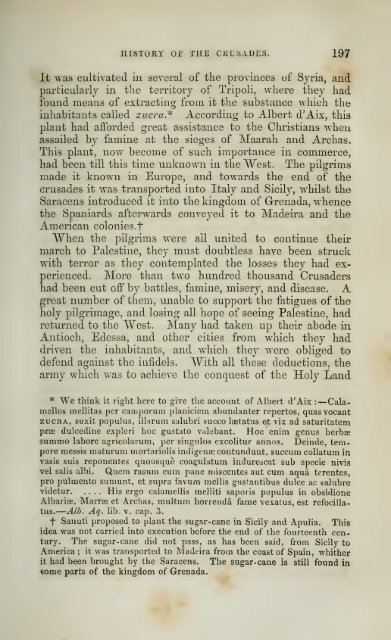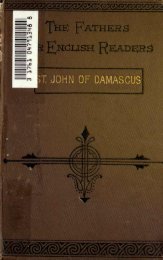- Page 2 and 3:
'^^ ^ ^ CV.;v DR. K.M. KHANTAMOUR A
- Page 5:
t z^
- Page 9:
THE HISTORY OF THE CRUSADES BY JOSE
- Page 12 and 13:
IV PKEFACE. cipally orally by those
- Page 14 and 15:
n PEEFACE. contriyed and executed b
- Page 16 and 17:
viil PEEFACE. Obrist, -we may justl
- Page 18 and 19:
X PEEFACE. This will certainly not
- Page 20 and 21:
Xl BIOGEAPHICAL NOTICE. Lis entranc
- Page 22 and 23:
X17 EIO GRAPHICAL NOTICE thinors be
- Page 24 and 25:
XVI 3310 GRAPHICAL ^'OTICE. who wat
- Page 26 and 27:
XVm BIOGEAPHICAL ^'OTICE. a century
- Page 28 and 29:
XX rs'TEODrcTioy. exhaust eitlier t
- Page 30 and 31:
Xiii INTEODUCTION. revolutions whic
- Page 32 and 33:
XXIV LNTEODUCTION. and acting toget
- Page 34 and 35:
XXVI CONTENTS. BOOK II.—A.D. 109G
- Page 36 and 37:
xxvm co^'TE^'Ts. destroy the fleet
- Page 38 and 39:
XXX CONTEXTS. the bravest nobility
- Page 40 and 41:
2 HISTORY OF THE CEUSADES. ^ St. He
- Page 42 and 43:
4i niSTOHT or the CErsADZS. • Hea
- Page 44 and 45:
niSTOET or THE CIiUSiJ)ES. • pene
- Page 46 and 47:
8 HISTOET or THE CKUSADES. tine, an
- Page 48 and 49:
10 niSTOET OF THE CEUSADE3. m tlie
- Page 50 and 51:
, vast 12 HISTOET OF THE CEUSADES.
- Page 52 and 53:
14 HISTOET OF THE CKUSADES. and opp
- Page 54 and 55:
16 HISTOST or THE CEUSADES. once pu
- Page 56 and 57:
18 HISTORY OF THE CRUSADES. affecti
- Page 58 and 59:
20 HISTORY OF THE CETJSADES. mucli
- Page 60 and 61:
22 HISTOET or THE CSrSAJDES. preser
- Page 62 and 63:
24 HISTOET OF THE CEUSADES. his pri
- Page 64 and 65:
26 HISTOET OF THE CBrSADES. the sto
- Page 66 and 67:
28 UISTOKT OF THE CHUSADES. brother
- Page 68 and 69:
30 HISTOET OF THE CEUSADES, to Pale
- Page 70 and 71:
32 HISTOEY OF THE CEUSADES. entered
- Page 72 and 73:
S-i mSTOEX OF THE CRUSADES. EitliYi
- Page 74 and 75:
36 HISTOET OF THE CEUSADES. try, an
- Page 76 and 77:
38 mSTOEY OF THE CEVSADES. noble fh
- Page 78 and 79:
40 * HISTOEY OF THE CRUSADES. tunit
- Page 80 and 81:
±2 nisTOEY or the ckusades. wliite
- Page 82 and 83:
44 niSTOEY OF THE CEUS.U3ES. East,
- Page 84 and 85:
46 HISTOET or THE CEUSADES. her hus
- Page 86 and 87:
48 HISTOET OF TRE CErSADES. The cou
- Page 88 and 89:
50 HISTORY or THE CRUSADES. were no
- Page 90 and 91:
52 jiisTOUY or THE crusades. childr
- Page 92 and 93:
54 niSTOET OF THE CRUSADES. had to
- Page 94 and 95:
56 HISTOUT OF THE CEUSA-DES. mised
- Page 96 and 97:
58 mSTOET OF THE CEUSADES. tion of
- Page 98 and 99:
60 HISTOKT OF THE CEUSADES. he Avli
- Page 100 and 101:
62 • niSTOET OF THE CEIJSADES. un
- Page 102 and 103:
G4 HISTORY or THE CRUSADES. the gov
- Page 104 and 105:
66 niSTOET OF THE CEUSADES. -vN-itl
- Page 106 and 107:
68 HISTOET or THE CBUSADES. placenc
- Page 108 and 109:
70 HISTOEY OF THE CRUSADES. cious t
- Page 110 and 111:
72 HISTOEY OF THE CEUSADES. Leytha,
- Page 112 and 113:
74 IIISTOBT OF THE CBrSADES. them,
- Page 114 and 115:
76 IIISTOKY OF THE CEUSADES. Son. F
- Page 116 and 117:
78 nisTOEY or the ceusades. savs ti
- Page 118 and 119:
80 HISTORY or THE CETJSADES. people
- Page 120 and 121:
82 nisTOEX or the ceusades. ^vas no
- Page 122 and 123:
84 niSTOEY OF THE CRUSADES. the han
- Page 124 and 125:
86 HISTOKT or THE CETJSADES. the cr
- Page 126 and 127:
88 HISTORY or THE CRrSADES. and lor
- Page 128 and 129:
90 HISTOEY OF THE CEUSADES. of the
- Page 130 and 131:
92 HISTOEY OF THE CiiL SADES. his p
- Page 132 and 133:
94 HISTOKY or THE CEUSADES. emperor
- Page 134 and 135:
96 HISTORY or THE CRUSADES. tlie Ea
- Page 136 and 137:
98 HISTOJBY OS THE Cri.USADES. the
- Page 138 and 139:
100 UISTOEY OF TJIE CRUSADES. cross
- Page 140 and 141:
102 HISTOKY or THE CRUSJJDES. priso
- Page 142 and 143:
104 niSTOET OF THE CEUSJJ^ES. tliei
- Page 144 and 145:
106 HISTOSY or TKE CHL'SADES. enemi
- Page 146 and 147:
lOS mSTOKY OF THE CEUSADES. Turks,
- Page 148 and 149:
110 HISTORY OF THE CSUSAHES. Before
- Page 150 and 151:
112 HISTORY OF THE CRUSADES. Sarace
- Page 152 and 153:
11^ niSTOET or THE CEUSADES. despai
- Page 154 and 155:
116 HISTOllY OF THE CEUSADES. lie r
- Page 156 and 157:
118 HISTORY OF THE CErSADES. of the
- Page 158 and 159:
120 HISTORY OF THE CfiUSADES. army,
- Page 160 and 161:
122 HISTOKY or TKE CEUS.U)£S. popu
- Page 162 and 163:
\lil^ BOOK III. A.D. 1097—1099. T
- Page 164 and 165:
124 HISTORY or TUE CfiUSADES. facti
- Page 166 and 167:
130 IIISTOEY or THE CRUSADES. Tvoul
- Page 168 and 169:
128 niSTOEY OF THE CErsAD£S. subui
- Page 170 and 171:
132 HISTOEY or THE CEUSJLDES. Thev
- Page 172 and 173:
134 UISTOET OF THE CltUSADES. whils
- Page 174 and 175:
136 HlSTOltT OF THE CRUSADES. to be
- Page 176 and 177:
138 HISTOET OF THE CEL'SADES. liis
- Page 178 and 179:
140 HISTOET OF THE CEUSADES. -when
- Page 180 and 181:
142 UISTOEY OF THE CEUSADES. compan
- Page 182 and 183:
I4i4i HISTORY OF THE CEUSADES. to e
- Page 184 and 185: 146 HISTORY or THE CIIUSJlDES. them
- Page 186 and 187: 148 HISTOEY OF THE CEUSADES. stancY
- Page 188 and 189: J.50 HISTOEY OF THE CEUSADES. only
- Page 190 and 191: 152 HISTORY OF THE CRUSADES. from i
- Page 192 and 193: — 154 HISTOEY OF THE CSUSADEa. eu
- Page 194 and 195: 156 IIISTOEY OF THE CEUSADES. lions
- Page 196 and 197: 158 msTOEY or the ceusades. East, f
- Page 198 and 199: 160 HISTOET OF THE CRUSADES. fice o
- Page 200 and 201: 162 HISTOET or THE CETJSADES. Tvere
- Page 202 and 203: 164! UISTOBY or THE CEUSADES. "but
- Page 204 and 205: 166 HISTOKT OF THE CEUSADES. mond,
- Page 206 and 207: 168 HISTORY OF THE CEUSADES. not ac
- Page 208 and 209: 170 nisTOEY or the ceitsades. bore
- Page 210 and 211: 172 UISTOEY OF THE CEUSADES. Christ
- Page 212 and 213: 174 HISTOET or THE CHL'SADES. inspi
- Page 214 and 215: 176 HISTORY OF THE CUV r.ADi-:.-^.
- Page 216 and 217: 178 HISTORY OF THE CRUSADES. opinio
- Page 218 and 219: ISO IIISTOET OF THE CRUSADES. viole
- Page 220 and 221: 182 HISTOEY or THE CEUS.U)ES. Tlie
- Page 222 and 223: 184 HISTOET or THE CEUSADES. this c
- Page 224 and 225: 186 HISTOET OF THE CEUS.U)ES. their
- Page 226 and 227: 1S8 HisroKY or the ckusades. Archas
- Page 228 and 229: 190 HISTOEY OF Til£ CPa'SAJD£S. c
- Page 230 and 231: 192 HISTOnY OF TnE CfiUS.VDES. eWde
- Page 232 and 233: 194 HISTOET or THE CBUS.U)ES. and t
- Page 236 and 237: 198 HISTOILY OJT THE CEUSADES. scar
- Page 238 and 239: 200 niSTORT OF THE CRUSADES. letter
- Page 240 and 241: 202 HISTOEY or THE CRUSADES. stars,
- Page 242 and 243: 201 KISTOHY OF THE CEUSADES. At the
- Page 244 and 245: 206 HISTOEY or THE CRUSADES. afterw
- Page 246 and 247: 208 HISTOEY OF THE CKUSADES. order
- Page 248 and 249: 10 HISTORY OF THE CEUSADES. existed
- Page 250 and 251: 212 HISTOEY OF THE CEIJSADES. suffi
- Page 252 and 253: 214 HISTOEY OF THE CEUSADES. faces
- Page 254 and 255: 216 IIISTOET OF THE CRUSADES. niins
- Page 256 and 257: 218 HISTOET or THE CErSADES, ance.
- Page 258 and 259: 220 — HISTOEY OF THE CEUSADES. ro
- Page 260 and 261: 222 HISTOET OF THE CKUSADES. and sw
- Page 262 and 263: 224 HISTOKY OF THE CEUSAJDES. Chris
- Page 264 and 265: 226 nisTOBT OF the ceusades. and, i
- Page 266 and 267: — — 228 nisTOHY OF the chusades
- Page 268 and 269: 230 KISTOET OF THE CEUSADES. in the
- Page 270 and 271: 232 nisTOET or the ceusades. Scarce
- Page 272 and 273: 234 HISTORY or THE CEUSADES. veiler
- Page 274 and 275: 236 HiSTOEv: or the ceusades. tlie
- Page 276 and 277: 238 HISTOEY OF THE CRUSADES. The re
- Page 278 and 279: 240 mSTOKY OF THE CEUSADES. The Chr
- Page 280 and 281: 242 HiSTOET or the ckusades. terrif
- Page 282 and 283: 244 HISTORY OF THE CEUSADES. him a
- Page 284 and 285:
246 HISTORY Oi' THE CBl'SADES'. nev
- Page 286 and 287:
24:8 niSTOEX OF THE CRUSADES. his d
- Page 288 and 289:
250 HISTORY Of tilt: CPlVSADES. Sav
- Page 290 and 291:
252 HISTOIIT OF THE CBUSADES. defil
- Page 292 and 293:
— 254 HISTOET or THE CHUSADES. Ch
- Page 294 and 295:
26Q HisTOEY or tue chusades. religi
- Page 296 and 297:
258 HISTOET OF THE CHUSADES. result
- Page 298 and 299:
2G0 nrsTORY of the crusades. tlie M
- Page 300 and 301:
262 HISTORY OF THE CEL'SADES. calle
- Page 302 and 303:
264 KISTOIIY OF THE carsADL3 part o
- Page 304 and 305:
266 HISTOEY OF THE CRUSADES. barren
- Page 306 and 307:
268 HISTORY OF the crusades. tlie t
- Page 308 and 309:
270 niSTOET OF TUE CRUSADES. should
- Page 310 and 311:
272 IIISTOET OF THE CRUSADES. recko
- Page 312 and 313:
274 nisTOET OF the crusades. C^esar
- Page 314 and 315:
276 HISTOEY OF THE CKUSJlDES. obtai
- Page 316 and 317:
278 HISIOKT OF THE CRUSADES. the sw
- Page 318 and 319:
280 HISTORY or THE CRUSADES. " It i
- Page 320 and 321:
282 niSTOEY OF TUE CCUSADrS. sade.
- Page 322 and 323:
284 HISTOET OF THE CEUSADES. name o
- Page 324 and 325:
286 HISTORY OF THE CEUSADES. enins:
- Page 326 and 327:
— 288 niSTOEY OF the crusades. mo
- Page 328 and 329:
290 niSTOET OF THE CfiUSADES. Baldw
- Page 330 and 331:
292 UlSTOHY OF TUE CRUSADES. of pen
- Page 332 and 333:
294 HISTOET OF THE CEUSADES. assemb
- Page 334 and 335:
296 HISTORY OF THE CRUSADES. Expell
- Page 336 and 337:
298 nisTOET OF the ceusades, liisto
- Page 338 and 339:
300 HISTOET OF THE CRTJSADES. A'irg
- Page 340 and 341:
302 niSTOET OF THE CEUSADES. prince
- Page 342 and 343:
304 HISTOET OF THE CErSADES. tribes
- Page 344 and 345:
306 niSTOKT OF THE CEUSADES. The Ol
- Page 346 and 347:
308 HISTORY or THE CRUSADES. the Ho
- Page 348 and 349:
310 niSTOHY OF THE CErSADE3. of the
- Page 350 and 351:
312 niSTOET or the ceusades. The ki
- Page 352 and 353:
314 HISTOEY OF THE CEUSADES. their
- Page 354 and 355:
316 nisTOEY or the ceusades. Accord
- Page 356 and 357:
318 HISTOEY or THE CKUSADES. promis
- Page 358 and 359:
S20 KDROET OF THE CBrSJLDBS. £rom
- Page 360 and 361:
322 nisTOET OF the cbusades. Turcom
- Page 362 and 363:
324 HISTOET OF THE CEUSADES. The ci
- Page 364 and 365:
326 HisTOEY or the ceusades. Friday
- Page 366 and 367:
328 HISTOEY OF THE CEUSADES. and th
- Page 368 and 369:
330 HISTOET OF THE CEUSADES. Clairv
- Page 370 and 371:
— 332 HISTOET OF THE CEUSADES. an
- Page 372 and 373:
334 nisTOKY or the ceusaues. then t
- Page 374 and 375:
336 nisroET of the csrsADEs. it ^va
- Page 376 and 377:
338 HiSTOET or the ceusades. out :
- Page 378 and 379:
340 HISTOET OF THE CETJSADES. Ms st
- Page 380 and 381:
342 HISTORY or the cnrsADEs. Lis pl
- Page 382 and 383:
34ri HISTOfiT OF THE CEUSADES. show
- Page 384 and 385:
346 histout of the ckusades. Nevert
- Page 386 and 387:
348 HISTORY OF THE CEUSADES. the pl
- Page 388 and 389:
350 HISTOET OF THE CEUSADES. \nll o
- Page 390 and 391:
352 HISTOBY OF THE CEUSADES. At a t
- Page 392 and 393:
354 HISTORY OF THE CETJSAHES. tas,*
- Page 394 and 395:
356 niSTOKT OF tue ceusades. alone
- Page 396 and 397:
358 HISTOEY OF THE CEUSADES. Avliic
- Page 398 and 399:
860 HISTOET OF THE CErSAI>ES. marcl
- Page 400 and 401:
362 HISTORY OF THE CETJSADES. worth
- Page 402 and 403:
364 niSTORY OF the ceusades. was sa
- Page 404 and 405:
866 nisTOEY OF the crusades. attack
- Page 406 and 407:
368 nisTOET OF the ceusades. selves
- Page 408 and 409:
370 HISTOEY or THE CEVSADES. Crusad
- Page 410 and 411:
372 HisTOBT or the ceusadzs. posaef
- Page 412 and 413:
374 HISTOET OF THE CEIJSADES. they
- Page 414 and 415:
376 HisTOET or the ceusades. and sp
- Page 416 and 417:
378 HISTOET OF THE CETJSADES. — s
- Page 418 and 419:
3S0 HISTORY OF THE cnrsA.DES. an en
- Page 420 and 421:
BOOK VII. THIED CEUSADE. A.D. 1148
- Page 422 and 423:
384 niSTOET OF the CErSADES. famili
- Page 424 and 425:
380 HISTORY OF THE CEUSADES. of the
- Page 426 and 427:
388 UlSTOST OF THE CRUSADES. from "
- Page 428 and 429:
ByO nisTOEY or the CErsADES. army a
- Page 430 and 431:
392 UISTOUT OF THE CRUSADES. bad a
- Page 432 and 433:
39^ niSTOHY OF THE CHrSADES. they w
- Page 434 and 435:
890 HISTOET OF THE CEUSADES. by fla
- Page 436 and 437:
398 HISTOKT OF THE CRUSADES. reputa
- Page 438 and 439:
400 HISTOKT OF THE CEUSADES. reofen
- Page 440 and 441:
4:02 IIISTOEY OF THE CETJSADEg. opp
- Page 442 and 443:
404 iiisTOiiY or TILE ciirsjLDEa. h
- Page 444 and 445:
406 HISTOET OF THE CRUSADES. intrep
- Page 446 and 447:
408 nisTOEY or the ceusades. to dec
- Page 448 and 449:
410 HISTOEY or THE CEUSADES. reigne
- Page 450 and 451:
412 iriSTOHY OF TUE CRrSADES. even
- Page 452 and 453:
414 HISTOEY OF TUE CiiUSADES. to th
- Page 454 and 455:
416 insTOiiY or the ceusades. brist
- Page 456 and 457:
418 HISTOET OF THE CEUSADES. instan
- Page 458 and 459:
420 HISTOET OF THE CEUSADES. tians
- Page 460 and 461:
422 nisTOEY OF the ceusades. that c
- Page 462 and 463:
424 HISTORY or the ceusades. Saladi
- Page 464 and 465:
42G UISTORY OF THE CEUSADES. but yo
- Page 466 and 467:
428 HJSTOEY OF THE CEUSADES. "^ sin
- Page 468 and 469:
430 HISTORY OF THE CErSADES. capitu
- Page 470 and 471:
432 nisTORT OF the ceusades. There
- Page 472 and 473:
43i insTOKT or the ceusades. to Egy
- Page 474 and 475:
436 msTOEY OF the cetjsades. v\-ere
- Page 476 and 477:
438 HISTORY or the CliUSADES, torre
- Page 478 and 479:
440 HISTOEY OF THE CRUSA.DES. been
- Page 480 and 481:
442 HISTOSY OF THE CRUSADES. aliena
- Page 482 and 483:
444 HISTORY OF THE CBUSADES. JLirv'
- Page 484 and 485:
446 HISTORY or the crusades. IseTO
- Page 486 and 487:
448 UISTOEY OF THE CEUSADES. "\\"he
- Page 488 and 489:
450 HISTORY OF THE CRUSADES. minded
- Page 490 and 491:
452 HISTORY or tue crusades. to dem
- Page 492 and 493:
454! HISTORY OF THE CEUSADES. nougl
- Page 494 and 495:
456 HISTOET OF THE CEU3ADES. vSalad
- Page 496 and 497:
458 HISTOEY OF THE CEUSADES. contin
- Page 498 and 499:
460 liisTony of the ceusades. troop
- Page 500 and 501:
462 uisTOiir of the ckusades. soldi
- Page 502 and 503:
464 niSTOEY or the crusades. seized
- Page 504 and 505:
466 HISTORY OF THE Cia'SADES. an in
- Page 506 and 507:
4G8 KISTOEY OE THE CKrSAJ)ZS. Spies
- Page 508 and 509:
470 HISTOET or THE CEUSADES. ^Mussu
- Page 510 and 511:
472 uiSTOET or the ceusades. The En
- Page 512 and 513:
474 HISTORY OP THE CRUSADES. presen
- Page 514 and 515:
476 HISTOKY OF THE CKUSADES. It was
- Page 516 and 517:
— 478 nisTOEY OF the crusaces. th
- Page 518 and 519:
480 HISTOEY OF THE CKUSADES. of Bon
- Page 520 and 521:
482 HISTOEY OF TUE cet:s.u)es. The
- Page 522 and 523:
484 HISTORY OF THE CRUSADES. advant
- Page 524 and 525:
4S6 HISTORY or TUE CEUSADES. the sl
- Page 526 and 527:
488 IIISTOET OF THE CRUS.IDES. The
- Page 528 and 529:
4i90 iiisTortY or the ceusades. out
- Page 530 and 531:
492 HISTOET OF THE CSrSADES. the Ch
- Page 532 and 533:
494 niSTOEY OF THE CEUSADES. servin
- Page 534 and 535:
496 uisTOEY or the crusjjjes. to th
- Page 536 and 537:
498 nisTOKT OF the chusades. reproa
- Page 538 and 539:
500 UISTORY OE THE CEUSADES. lose t
- Page 540 and 541:
502 HiSTonr or the CErsADEs. Their
- Page 542 and 543:
50^ msTOiir or tile ceusades. selve
- Page 544 and 545:
506 nisTOEY or the crusades. The th
- Page 546 and 547:
50S msTOET or the ceusades. and whe
- Page 552:
:> University of California SOUTHER

















